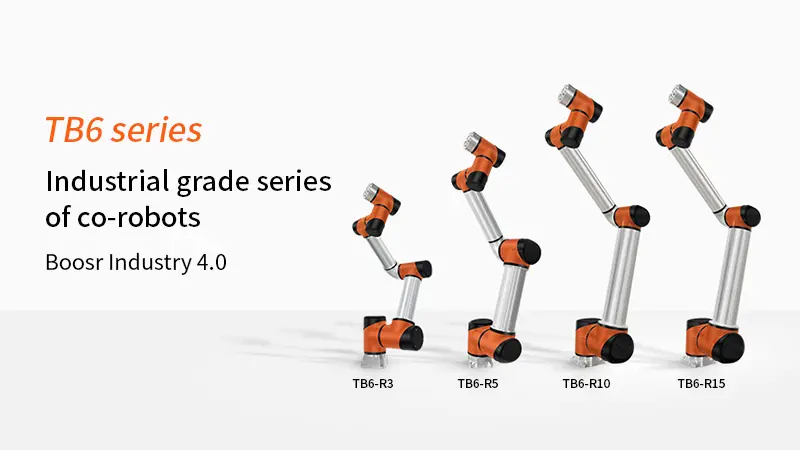Analysis of China’s co-robot industry in the next few years
Date:2020-10-27Co-robots are an important branch of industrial robots. Co-robots are mainly lightweight in design, relatively simple in structure, and insufficient rigidity of the entire robot. Therefore, the load of co-robots is generally lower than that of traditional industrial robots, and the working range is only similar to that of a human arm. Products with collaboration as the main technical feature, including single-arm co-robots, dual-arm co-robots, composite robots, mobile dual-arm co-robots, table tennis robots, etc.; among them, dual-arm co-robots have loads of 3kg and 5kg, single-arm co-robots Loads include 3kg, 5kg, 10kg, 15kg, and 20kg. The product application of co-robots meets the needs of precision assembly, testing, and human-machine joint operation. It is currently implemented in the automotive, 3C, semiconductor, and medical fields, and is involved in the production of electronic products. Complex processes such as welding, assembling, grinding, and testing.

1. Collaborate with people and give full play to the advantages of people and robots
The "In-depth Research and Investment Prospects Report on China's Co-Robot Industry for 2020-2024" released by the China Investment Industry Research Institute shows that, compared with industrial robots that have been developed for decades, the biggest breakthrough of co-robots is that they can directly stand by human Cooperation without the use of safety fences for isolation. This method not only reduces the distance between humans and robots but also greatly reduces the area occupied by the workstations. More importantly, it can fully combine the advantages of humans and machines and learn from each other. , Let robots assist humans to complete those highly repetitive, high-precision tasks, while humans solve tasks with high flexibility and continuous optimization. When assembling high-precision heavy parts, human-machine collaboration highlights its advantage of combining the advantages of humans and machines.
2. High security
High safety is one of the basic characteristics of co-robots. At the beginning of its design, it aims to provide a safety guarantee for human-machine interaction. Therefore, to realize the safety of human-machine collaboration, co-robots generally adopt lightweight designs, such as lightweight Body shape, application of endoskeleton design methods, etc.; limit operating speed and motor power; use joint torque sensors for contact detection, safety controller technology, etc. to ensure human safety, which is a way to avoid injury from the root cause the way.
3. Simple deployment, flexible and easy to use
Co-robots generally support dragging and teaching, equipped with an intuitive user programming interface, integrated simple operation, easy-to-master software system, and modular encoder, etc. Ordinary workers can pass certain training after unpacking in most places Many deployment tasks are completed, so deployment is simple. Also, the lightweight co-robot can be installed on a desktop or on a device, which is very flexible.
4. the cost is lower
The cost of industrial robots generally includes both the price and deployment of the robot itself. The price of co-robots is generally 10-20w. Due to the characteristics of easy programming and installation, the cost of deployment is generally low. Also, lightweight co-robots have greatly reduced space requirements, which can reduce many installation and plant costs for enterprises. An industrial robot used in mainstream occasions has a price range of 10w-40w according to the load capacity, and the cost of deployment is even higher, at least 2-3 times the price of the robot.
5. support flexible production mode
The collaborative machine robot breaks through the limitation of the safety guardrail and can be free from the constraints of a fixed geographic location. Instead, it can quickly adapt to new production tasks in different places with simple programming and training according to actual needs. Good support for the flexible production model. Even if a robot malfunctions, it can be quickly supplemented by a new robot.

2018-2020 China's co-robot industry market size analysis
In China, companies have also continued to increase in the co-robot industry. In 2017, the size of China's co-robot market reached 570 million yuan. In 2018, the size of China's co-robot market was 930 million yuan, a year-on-year increase of 47.62%; from 2014 to 2018, the average annual compound growth rate of the co-robot market was 64.83%. In 2019, my country's co-robot market reached 1.3 billion yuan, a year-on-year increase of 42.9%. The robotics industry has faced certain growth pressures since the second half of 2018, but the capital's attention to robots is still relatively high, and newcomers in the field of co-robots are still increasing.
For co-robot manufacturers, the potential incremental space is large enough, and the key lies in the mining of application scenarios and the grasp and breakthrough of processes. 3C and auto parts are the two most widely used areas of co-robots, which are influenced by 5G and smart cars. Driven by the trend, there will be changes in new materials and new processes. This is both an opportunity and a challenge for co-robots. How to adapt to the trend and seize the opportunity will be the key to the development and transformation of enterprises.
Previous Article: Why do we need collaborative robots in manufacturing?
Next Article: Important technical parameters for co-robot selection